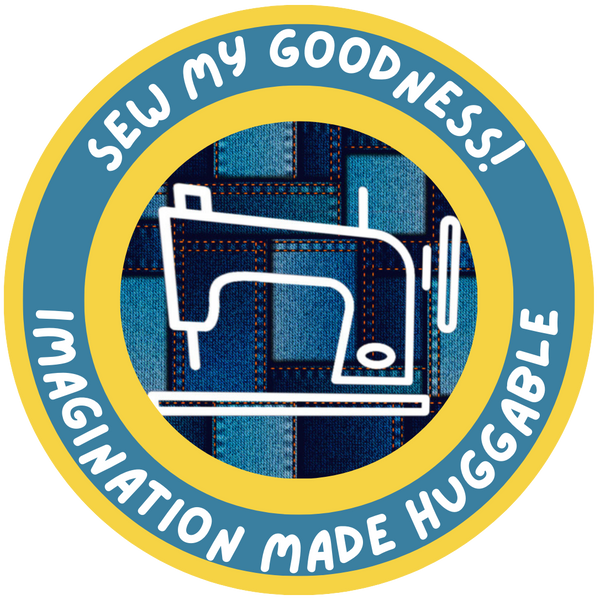Last week at sewing camp, one of my brilliant students announced that he could probably design sewing patterns for me using AI. I paused to imagine a 10-year-old taking over my pattern drafting empire, then laughed nervously and changed the subject.
Days later, I was down the rabbit hole, collaborating with Sparky (I call my AI Sparky because… he told me I could) to create something absurd and joyfully snuggleable, a stuffed sewing machine.
A Little Backstitch Through Time
Before we dive into my modern tech adventure, let’s take a quick trip way, way back:
The first known sewing needle was found in a Siberian cave and dates back over 50,000 years. It was crafted not by our species, Homo sapiens, but by a now extinct cousin of ours, the Denisovans. I wonder if there were Denisovan seamstresses who were outraged by the new tech. “Now everyone thinks they can mend their own mammoth pelts!”
Fast forward to the 1800s:
When the first sewing machine factory opened in France, local tailors were so convinced this new invention would steal their livelihoods that they rioted and destroyed the factory. Sound familiar? (Cough, cough. AI panic, anyone?)
Sewing machines didn’t eliminate tailors. Instead, they gave them a powerful tool to create more, better, and faster. Progress, turns out, often looks scary at first.
Enter Sparky: My Digital Sewing BFF
When I was putting together a highlights reel for stuffed animal camp, I had a fun thought:
“Hey Sparky, could you turn my sewing machine logo into a stuffed sewing machine? Like, literally plush, squishy, adorable.”

Seconds later, Sparky delivered this charming image. I was smitten.
It was oddly perfect, a patchwork stuffed sewing machine that was just begging to be made real.
The Creative Mayhem Begins
Sparky and I brainstormed together in the weirdest (and most fun) way possible.
- First, we tried draping, just like fashion designers do, pinning and shaping fabric over a 1950s Singer to draft pieces directly. That might have worked, as Sparky was guiding me through the process, step-by-step, and I will probably go back to it at some point but I was pulled away by another idea.
"Hey Sparky, what if we hack a horse pattern?" We wondered together if a horse’s head and rump might somehow translate to a sewing machine’s arm and post. Spoiler: very close but not quite.
- Finally, Sparky sketched out some simple template shapes, a side panel, a top arch, a little wheel piece, which became the foundation for my stuffed sewing machine pattern. I taped it together in paper form and then sewed a few versions with scrap fabric.
Now, to be fair, Sparky didn’t nail the pattern completely. Some of the shapes were a bit too small and fussy for actual sewing. Turns out, you probably need a bit of real-life sewing experience to understand how tiny curves behave under a presser foot. And sewing a donut shape with no external seams is something akin to making a Klein bottle out of fabric (not really, but that’s what it felt like… And now Sparky and I have our next project. A fabric klein bottle! I. CAN'T. WAIT!) so there was plenty of adjusting and reworking along the way.
Throughout the process, Sparky was gently pushing me:
“Maybe try breaking it into logical pattern pieces.”
“What if you sew four hourglass-like shapes together for more roundness?”
“It doesn’t have to be perfect. You’ll learn as you go.”
And he was right. I tried, failed, seam-ripped, adjusted, and eventually, success!
(Though, if you swipe through my photos, you’ll spot the hilariously wonky prototypes. Embrace the process, right?)
I made the final creation out of outgrown toddler blue jeans (sentimental upcycling) and stuffed it with the fluff from dozens of “retired” stuffed animals (shhhhhh… no one can know about this). I even modified the little handwheel so it actually turns, just like a real sewing machine. It's not just adorable, it’s also a sweet little memory quilt in machine form.
Lately, I’ve read articles about schools outright banning AI tools, terrified that students might stop thinking for themselves or "cheat."
It’s the same old story:
- Cave dwellers cheating with needles.
- Tailors smashing sewing machine factories.
- Teachers banning calculators.
- Parents wringing hands over computers.
But the sewing machine didn’t wipe out tailors. It made them more creative and productive. AI didn’t replace my pattern-making skills. It just gave me a fresh spark (pun intended). It was a playful collaborator who offered ideas, sketches, encouragement, and even new ways to think about 3D shapes and inspiration for future projects.
Progress is always met with a bit of fear.
But more often than not, it doesn’t erase the artisans. It empowers them.
Just like the sewing machine supercharged the tailor, this quirky stuffed machine project proved that new tools can expand what we’re capable of, not diminish it.
Here's a quick video of my process:

